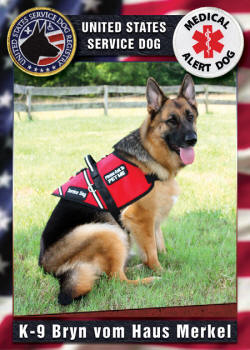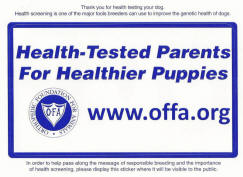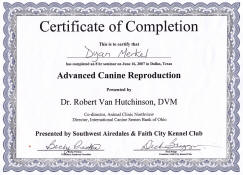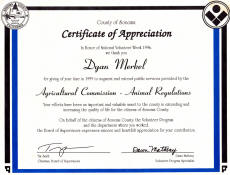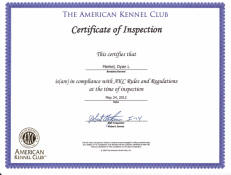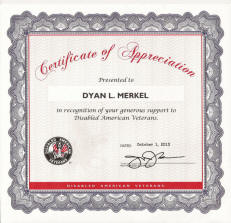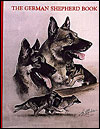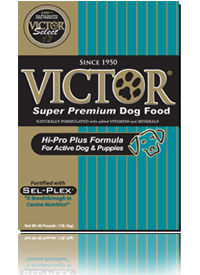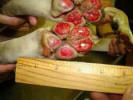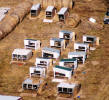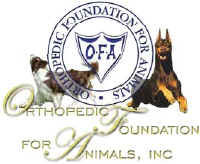|
TRAINING
YOUR GERMAN SHEPHERD PUPPY
Great quote from old time
dog trainer:
"If you want to know what's wrong with your dog, go
look in the mirror. " |
|
TRAINING TIP: Let’s talk about
positive training and why it is so effective.
Positive training means rewarding your dog for a
desirable behavior. When your dog exhibits a
behavior you like, you show your dog that you like
that behavior by rewarding your dog. A reward is
anything your dog enjoys such as food, throwing a
ball, a game of tug, or praise. Rewarding your dog
will encourage your...
dog to repeat that behavior again. By repeating the
behavior, your dog will get good at practicing it
until the behavior becomes learned. Correction based
training in my opinion isn’t training at all. It is
not based on intelligence or compassion. Jerking a
dog's neck or shocking a dog into "submission" will
only serve to cause a dog to become fearful. Pain
and discomfort decrease your dog's ability both to
learn and to play. Positive training sets your dog
up for success by teaching him what you would like
him to do so there is no need to punish or to get
angry with him. Through positive reinforcement you
will teach your dog how to behave in new
environments and perform behaviors you want. It’s
truly amazing to see how positive reinforcement
strengthens the bond between you and your dog,
builds his confidence and teaches him to trust.
www/PatriotPaw.org |
-
Start your training the
moment your puppy comes home.
-
Always give your dog a
treat when you call him to you.
-
Train before meals or
when your dog is relaxed and hungry
-
Your German Shepherd
puppy was bred for extreme trainability so limit your training to under
5 minutes (short and sweet).
-
A daily routine builds
good learning habits.
-
Always end on a high
note, when the puppy has done what you asked right, lots of praise.
-
Do not over train.
Your puppy will lose interest and not retain what it did learn.
And he may go into avoidance. If he goes into avoidance, stop all
training for a week or so until he solicits you to play.
-
Praise, Praise, Praise.
-
Training up until a year
of age is all motivational. We start with food. Vienna hot
dogs cut in little pieces. There are lots of training treats
available at Pet Markets too. Just make sure that whatever you do get
it must be in tiny pieces for the training or your dog will be so busy
eating the biscuit that you won't have time for the training. You
want your puppy to quickly eat the treat and immediately after look at
you for more.
-
Hold your treat up by
your face so that the puppy will learn to look you in the eye. If
you don't have your puppies attention your puppy will not learn.
-
Always use a quiet area
with few distraction or interruptions.
-
Only one person at a time
should train. Qualified children should always be supervised by a
knowledgeable adult, your dog can be confused easily.
-
Consistency counts.
I will spend 2 weeks alone on sit. Twice a day for a few minutes.
After the puppy is good with the sit, I will turn my back, call the pup
and generally the puppy will come around to my front and sit directly
in front of me.
-
Stay and Down are
negative commands and I generally don't work on them until the dog is
older. However you can teach the down easily with food so it
is not associated with negative training.
-
Heeling can be taught by
holding a treat/toy in front of the dogs face as he walks on the left
side of you. The dog will associate you with food/toy and keep his
eyes on you instead of everything else that is out there.
-
NEVER hit or shout at
your dog for not obeying a command.
-
Harsh corrections can
result in fear and aggression - both are counter productive to learning.
-
If your dog misbehaves,
he should be reprimanded consistently and immediately. A firm,
verbal rebuke is enough. Don't rebuke your dog for doing something
you didn't see at the moment.
TEACHING SIT:
Hold the treat so the dog
looks up to get it. As the dog tips its head up it will they will
automatically sit. Consistency of working this way with the sit will
produce the response on command.
TEACHING DOWN:
Command your dog to 'sit',
then sit down in front of him. Hold a small piece of food in front
of his nose. As you command 'down', move the food down to the ground
so his nose follows it. If he need help, put your hand on his
shoulders and guide them down. When he is lying down, praise him and
give him the treat. You can also push the treat between your puppy's
front legs, as he tried to follow it his back end will slide into a down
position. Praise him and give him the reward.
TEACHING (HERE) COME:
From
the very first day you bring your puppy into the house he should be
given a treat every time you call him to you. After your puppy
learns the sit you can combine the 'come' with the 'sit' and then give
the treat/reward. And always lots of praise and excitement when
your dog comes to you. NEVER, NEVER call your dog to
you for punishment. NEVER use his name negatively or during a
punishment phase (I would prefer that you take time out for yourself
before you even consider a punishment phase for your dog).
If you instill in your dog from day one that it is exciting and
rewarding to come to you he will sail through his teenage stage eagerly
wanting to please you. This could also save your dogs life
to know that he is 100% on the recall.
I recommend
once you have these commands working smoothly with your dog that you join
a local obedience club and work on putting all of this together in a
routine so you can be a team. This is usually after the teenage stage
and about 13 -14 months of age.
CRATE
TRAINING:
We crate train
all puppies from the day that they are weaned. My advice to you when
you start is to put the puppy in the crate and then take the whole family
to the movies so you won't have to listen to him throw a temper tantrum.
Your puppy will adjust quickly to his crate. Do not take the puppy out if he is
throwing a fit as it will allow him to manipulate you whenever he wants.
I always try to let the puppy out when he is quiet or asleep. Once your puppy gets use to
being crated you will be able to
tell when he has to go to the bathroom...his cry will be much different
than that of a temper tantrum.
More on
Motivational Training
Housebreaking
Rule #1:
If you don't catch your puppy making an "accident," don't punish
him for it.
Housebreaking Rule #2:
When he does it right outside, praise him!
Housebreaking
your new puppy doesn't have to be hard or messy, nor should it take very
long if done right. Getting your dog to do its business outside is a matter
of training, and the more attention you can give to your puppy during
this crucial training, the shorter this awkward stage will last.
Methods of housebreaking
Starting Inside: There are several ways to housebreak
a puppy. With the first, you can put down papers or pretreated pads, encouraging
them to use these areas for going to the bathroom. The pads are scented
with a chemical that attracts the puppy to use them. Whenever you see
them starting into their "pre-potty pattern," such as walking
around and sniffing the floor, you gently pick them up without talking
and carry them over to the papers/pad and then praise them when they go
to the bathroom.
When all goes well and they are using the papers consistently, the papers
are either moved closer to the door and/or another set is placed outside.
The transition is made from concentrating the toilet habits to one spot
inside the home to one spot outside the home. Finally, the papers inside
are eliminated. The only problem with this method is that for a period
of time it encourages the animal to eliminate inside the home. In our
experience, housebreaking may take longer when this method is used.
Crate Training: The second popular method of housebreaking
involves the use of a crate or cage. Make sure the crate isn't too large
- just big enough to fit their sleeping blanket or mat. Dogs do not like
to soil their beds because they would be forced to lay in the mess. It
works, and while in these confines, most pups will control their bladder
and bowels for a longer time than we would expect. Young puppies, at 8
or 9 weeks of age can often last for 7 or 8 hours, however, we would never
recommend leaving them unattended in a crate for that long in most circumstances.
During housebreaking, whenever the puppy is inside the home but cannot
be watched, he is placed in the crate. This might be while you are cooking,
reading to the children, or even away from the home. The last thing you
do before you put the puppy in the crate is take him outside to his favorite
spot. The first thing you do when you take the animal out of the crate
is another trip outside. No food or water goes in the crate, just a blanket
and maybe a chew toy to occupy his time. Overnight is definitely crate
time. As your faith in the puppy grows, leave him out for longer and longer
periods of time.
Constant Supervision: The last method involves no papers,
pads, or crates. Rather, you choose to spend all the time necessary with
the puppy. This works very well for people who live and work in their
homes, retired persons, or in situations where the owners are always with
the animal. Whenever they see the puppy doing his "pre-potty pattern"
they hustle him outside. It is important that the dog is watched at all
times and that no mistakes are allowed to occur. When he is taken outside,
use a leash or lead to keep him less distracted and watch the puppy closely
- as soon as all goes as planned, he should be praised enthusiastically.
Do not play until after the pup goes so he learns to go quickly on command.
Use Simple and Consistent Verbal cues
Specific
verbal communications will also help the two of you understand what is
desired. It is an excellent idea to always use a word when it is time
to head to the bathroom. We like "Outside?" Remember that whenever
you use a verbal command or signal, it is important that everybody in
the family always uses the same word in the same way.
Once
outside, we try to encourage the pup to get on with the act in question.
We use the phrase "Do your numbers." Others use 'Do It,' 'Potty,'
or 'Hurry Up.' As soon as your pup eliminates, it is very important to
praise them with a "Good Dog" and then come back inside immediately.
Again, make this trip that started outside with a specific word "Outside"
be for a purpose. If we are taking the pup out to play with a ball or
go for a walk we will not use this word even if we know they will eliminate
while we are outside.
If
Accidents Happen
One
of the key issues in housebreaking is to follow Rule Number One: If you
do not catch your puppy doing it, then do not punish him for it! We do
not care what someone else may tell you or what you read, if you find
a mess that was left when you were not there, clean it up and forget it.
Discipline
will not help because unless you catch the puppy in the act, he will have
no idea what the scolding is for. At this point in his life a puppy's
memory is very, very poor. Your puppy has urinated and defecated hundreds
of times before he met you. Nobody made a fuss before and the pup will
not relate the punishment, regardless of its form, together with something
he has done without incident numerous times before. Especially if he did
it more than 30 seconds ago! Puppies are just like our children. Unless
something was really fun (and a repetitious act like going to the bathroom
is not), they are not thinking about what they did in the past. They are
thinking about what they can do in the future.
The
same should be said as to your first reaction when you actually catch
them in the act of urinating or defecating. Do not get mad. Quickly but
calmly pick them up and without raising your voice sternly say "No."
Carry them outside or to their papers. They are going to be excited, but
stay there with them a while and if they finish the job, reward them with
simple praise like "Good Dog."
Remember,
though the housebreaking process may get frustrating at times - especially
the times cleaning up the occasional accident - be patient and stay calm.
If you want housebreaking to go quickly, regardless of the method you
use, follow these simple tips and try to spend as much time as possible
with your puppy. |
|
Collars and harnesses
Choke Collar: The choke collar is a length of
metal-link chain with a large circular ring on
either end. The chain is slid through one of these
rings and it is slid over the dog's head. When the
dog displays an undesirable behavior the collar is
tightened. This is primarily used in traditional dog
training. These collars should never be left
on a dog when he is not in training.
Prong (or Pinch) Collar: The prong collar is made
of metal links that fit together by connecting
through long teeth that point inward toward the
dog’s neck. A section of this collar is made of a
loop of chain links that tighten the collar when
pulled, pinching the dog's neck. This collar
is mainly used in traditional dog training for hard
to handle dogs. Also used for cleaning up
obedience and bitework training to help the dog
become more precise. This collar should not be
left on the dog and is recommended for professional
use only.
Radio-controlled Collars: These consist of a
radio receiver attached to the collar and a
transmitter that the trainer holds. When triggered,
the collar delivers an aversive. The specific
aversives vary with different makes of collars. Some
emit sounds, some vibrate, some release citronella
or other aerosol sprays, some apply electrical
stimulation. A few collars incorporate several of
these. Of these, electrical stimulation is the most
common and the most widely used. Modern
electrical collars are adjustable, allowing the
trainer to match the stimulation level to the dog's
sensitivity and temperament. They deliver a
consistent and measured level of aversive
stimulation, ranging from a tickle, tingle, twitch,
or a prickly twinge to a highly aversive electrical
event that produces significant discomfort and
startle but without risk of producing physical
injury or pain. Although these collars are
inappropriate for use as the initial or primary
means for establishing basic obedience control, no
comparable techniques or tools can currently match
the efficacy or safety of them for establishing safe
and reliable off-leash control. Not to be used by
novice handlers.
Martingale Collar: The martingale collar is a
collar that has only a section on it that will
tighten when pulled. This is different from the
choke collar that will tighten indefinitely.
Head Collar: The head collar is very similar to a
halter on a horse. The theory it is that if you have
control of the head, you have control of the body.
The head collar generally consists of two loops. One
loop goes behind the ears and the other goes over
the dog's nose and they meet somewhere below the
dog's jaw. This tool makes it more difficult for the
dog to pull on his leash. This tool is usually
employed during positive reinforcement training.
No Pull Harness: The no-pull harness is worn on
the body of the animal. The no-pull harness differs
significantly from the standard harness since it
makes it harder for the dog to pull because it
distributes energy over the dog’s back and
shoulders. The no-pull harness restricts the
movement of the dog’s body when the dog pulls. Like
the head collar, the no pull harness does not teach
the dog not to pull; it only makes it harder for the
dog to pull. This harness is generally used during
positive reinforcement training.
|
This site
designed and maintained by Dyan Merkel of
DLM DESIGN STUDIO
|

